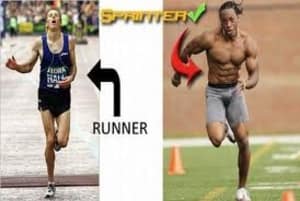Which Body Would You Prefer?

When many people look to make aesthetic fitness changes to transform their body and both look and feel good are they matching the program to their preferred body they want to achieve? Before we get into the science behind the game planning to achieve your desired results, I believe it sometimes better to start with the end in mind.
Look at the distance runner and the sprinter. We can argue that both are fit; however, when it comes to being shaped and tone you can see how the sprinter’s body is more defined, lean, shaped and tone. My purpose of this article isn’t to tell you which body you should prefer; rather explain the training differences so you have a clearer path of how you should be training pending the body type you prefer so not to waste time, energy and even money.
If you prefer the distance runner body shape, good news is it is a rather simple aerobic program design in that all you need to do is run and keep running and hope your joints withstand the repetitive beating. Ideally, to be proactive with your training and minimize injury with a distance runner body type in mind, it is strongly recommended to incorporate some progressive resistance training and adequate supportive nutrition fueling to minimize the catabolic (breaking down of muscle tissue) effect created from chronic typically steady-state (same pace) aerobic training.
However, if the image you want of yourself is more of the sprinter’s type body where you are more defined, shaped and toned then your program should be more of the anaerobic (without oxygen) type exercises. Typically, these exercises consist of Heavy weight training (repetitions not greater than 15 while finishing near momentary muscular fatigue) or intense metabolic bouts of exercise of short duration and minimal recovery between bouts.
The advantage that anaerobic training provides over traditional aerobic training is a process called EPOC or Exercise Post Oxygen Consumption. EPOC is the residual or “after-burn” from a workout enabling your body to burn calories above resting levels even though you are at rest (not exercising). Studies have shown metabolism being elevated 12-38 hours after the completion of a workout due to EPOC. How is that for time management?
This EPOC “after-burn” is the key to maximizing metabolism for fat loss in an exercise program. If you were to exercise an hour per day seven days per week that is only 4.2% of your week, leaving 95.8% of your week at lower resting metabolism levels. If you truly want to shed the fat, leverage the EPOC effect and become the creator of your metabolism, not the victim.
Why and how EPOC provides this advantage is by understanding the value of skeletal muscle. First, muscle is your metabolism. The more muscle you have the better metabolism you will have based on how you move it. Why muscle is your metabolism is because the only place fat is utilized for fuel is in the muscle cell while in the presence of oxygen. If you can perform exercises that activate or increases muscle while also continue to provide higher levels of oxygen to those muscles after the exercise is completed now are you performing the most effective form of exercise when it comes to fat loss.
Now you can see why EPOC and anaerobic training is the number one component in a fat loss exercise program when it comes to shedding fat. This is not to say, aerobic training shouldn’t be a part of the program, rather it just shouldn’t be the primary focus. In the “Hierarchy of Fat Loss” a term we use here at My Fitness Kitchen® to describe this scientific process, only Supportive Nutrition trumps having a concern for muscle via anaerobic training when it comes to maximizing fat loss. Unfortunately, many individuals when they embark on a program to lose fat get shaped and tone, the do the complete opposite of this Hierarchy.
Remember fat loss comes down to expending more calories than you consume which is why this “after-burn” by-product is so valuable. Therefore, with the EPOC created by this style of training, individuals now can leverage the time when they are not exercising to better assist in the fat loss process with a greater overall total caloric burn.
We could go on in greater detail of the science of training for fat loss and various body types. However, to summarize, if you want you to get lean and tone, break away from traditional thinking of steady state cardio exercise only and more toward progressive resistance training and metabolic interval training. Again, this isn’t to say you can’t do aerobic type training (e.g., distance running); however, if you are, be sure to have a concern for muscle so you can maximize the EPOC effect and minimize the potential loss of muscle (metabolism) that chronic aerobic training can create.
From an Exercise Physiologist perspective into the training of the two body types; it is rather simple by looking into the energy systems that supply the body to perform the type of work. A distance runner is one that is aerobic (with oxygen); whereas the Sprinter is anaerobic (without oxygen).


